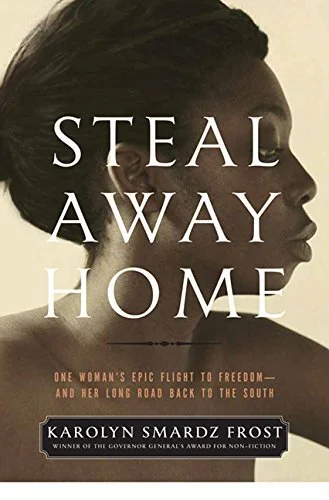Steal Away Home: One Woman's Epic Flight to Freedom
The first thing I wanted to do after reading Karolyn Smardz Frost’s previous book, I’ve Got a Home in Gloryland: A Lost Tale of the Underground Railroad, was run down the Esplanade to the public school and tell all the black children about the neighbourhood’s history. This was in 2007. I was living at 2 Market Street, across from St. Lawrence Market in Toronto. My children had attended Market Lane School, and when I occasionally dropped by to deliver a lunch, the littlest black kids would pause and stare. I would be wearing a dress and carrying books, and they thought I might be a black teacher. This made me sad. I knew they noticed their teachers were white, and that they were not, and that—in some vague way—they were outsiders in their school and neighbourhood.
But I’ve Got a Home in Gloryland celebrated the area’s black history. It is the true story of African Americans Lucie and Thornton Blackburn, who escaped slavery in Kentucky in 1831 and eventually settled in Canada. From their house a few blocks east of the school, they operated Toronto’s first taxi service.
Smardz Frost’s latest work magnifies our understanding of black life in 19th-century Toronto, illuminating the community’s role in the abolitionist politics of the day. Steal Away Home: One Woman’s Epic Flight to Freedom—And Her Long Road Back to the South is the biography of Cecelia Jane Reynolds, an African American slave who escaped to Canada. Reynolds belonged to Fanny Thruston of Louisville, Kentucky, who was related to William Clark of the Lewis and Clark Expedition and to the Churchills of Churchill Downs. Her father, Charles Thruston, had sold Cecelia’s father away when the girls were young. Even so Fanny and Cecelia, her maid, remained close. But in June of 1846 when the Thrustons were vacationing in Niagara Falls, New York, 15-year-old Cecelia escaped by boat across the Niagara River.
Virginia-born Benjamin Pollard Holmes, a waiter on the steamboat City of Toronto, helped orchestrate Cecelia’s flight. Benjamin and Cecelia soon married and settled in a house in the heart of Toronto’s black community.
Cecelia had left her mother and brother behind in Louisville. She wrote to Fanny about her desire to purchase their freedom. That letter initiated a rare and affectionate correspondence between Cecelia and Fanny that would last until the two reunited in Louisville after the Civil War.
Steal Away Home offers a panoramic view of black Toronto in the mid 1800s, a population not nearly as invisible as history would have us believe. Composed of generations of refugees, blacks made up about 1,000 of the city’s overall population of 25,000. Most resided in Macaulay Town, which ran several blocks north from Osgoode Hall.
Smardz Frost characterizes the area as a settlement neighbourhood where many people arrived in desperate need. Yet a significant number of Macaulay Town residents established businesses, owned homes, educated their children and secretly worked for the Underground Railroad. The community’s most respected couple was Wilson and Ellen Abbot. Their son, Anderson Ruffin Abbot, was the first black Canadian doctor.
1903 - Overhead view of St. James Cathedral (City of Toronto Archives, Fonds 1568, Item 278)
In June of 1846, Cecelia and Benjamin disembarked at the foot of Church Street, one street west of Market. Cecelia was a little nervous to see only two black men working on the docks. But more signs of black life in the city emerged as they walked along: by the time the pair reached Front Street, one block north, she had passed two black barbershops and a couple of black-owned restaurants. East along Front Street, Cecelia spied the St. Lawrence Market, where several black vendors sold their wares. West down King Street from Church Street stood James Mink’s livery stable. Mink, the son of Canadian slaves, also owned a popular hotel. Rising before them at Church and King was the impressive St. James Cathedral. Here, clergy assisted African American refugees and baptised black children. This is where Benjamin and Cecelia would be married.
I began my own inquiry into black Canadian heritage at St. James Cathedral. In the early 1980s, I had no inkling of the church’s connection to fugitive slaves, but Lorraine Hubbard, executive director of the Ontario Black History Society, suggested we meet on a bench on the grounds. If she had any knowledge of the cathedral’s black history, she did not mention it to me. Lorraine told me about her great grandfather, William Peyton Hubbard, Toronto’s first black alderman, whose name is still etched in the window of an office down the street. Years later when I moved to Market Street, I would get up before dawn to sit quietly in the cathedral gardens.
Canada’s missing black history has been the subject of ongoing debate. In his book, Done with Slavery: The Black Fact in Montreal, Frank Mackey explains the black presence in the land that would become Canada was so negligible that it was overlooked by fact collectors of the time and eventually forgotten. But how could historians, who have never stopped talking about the Underground Railroad, simply forget about its passengers?
With Steal Away Home Karolyn Smardz Frost wants readers to look beyond the stories of escaped slaves and the Underground Railroad to the ordinary—sometimes extraordinary—lives these individuals managed to build.
Steal Away Home opens at the present day excavation site of Cecelia and Benjamin’s Centre Street home where Cecelia helped raise Ben’s two young sons. Ben was mostly away working. When he did return, it was often with an escaped slave. Cecelia, like all Macaulay Town wives, had to be ready for unexpected guests.
Some women took in sewing or laundry or served as domestics. Cecelia enrolled in classes, attended church functions and anti-slavery lectures. When the North American Convention of Colored Freedman met in Toronto in September 1851, she helped cater meals. The convention was organized by Henry Bibb, publisher of Voice of the Fugitive, the first black newspaper in Canada.
Delegates attended from across Canada and America, including Bibb’s nemesis, Mary Ann Shadd, whose abolitionist paper, the Provincial Freeman, would operate, for a time, out of an office at Jarvis and King. George Brown, publisher of The Globe, was on hand as well. Brown, an influential abolitionist, joined forces with Bibb, Wilson Abbott and others to establish the Anti-Slavery Society of Canada.
Smardz Frost’s material is thoroughly engaging, yet, reading it, I felt some resentment. Why hadn’t I encountered this history in school? Why hadn’t my children? I wondered how many Canadians know the founder of our national newspaper was an ardent abolitionist. I wondered if anyone could mistake today’s Globe and Mail for a paper with an abolitionist past.
Yet for all this detail into the lives of those who fled, Smardz Frost virtually ignores the history of Canadian slavery, which would have provided significant context for her tale. When Smardz Frost does mention Canadian slavery, she has a tendency to split hairs, describing slave owners as “Loyalists” and not Canadians. She does not discuss the slave owners who hamstrung Simcoe’s efforts to abolish slavery, or explain that sometimes Canadian slaves fled south.
Steal Away Home: One Woman's Epic Flight to Freedom - And Her Long Road Back to the South by Karolyn Smardz Frost
HarperCollins Publishers
432 pages
Steal Away Home shares characteristics of black Canadian fiction. The story is peripatetic; like Aminata in Lawrence Hill’s The Book of Negroes, Cecelia and her family are always on the move. Cecelia’s life takes her from Louisville to New York to Toronto to Liverpool, England, then back to Toronto, New York and, finally, Louisville again. Ben travels to Australia hoping to strike it rich in the gold rush, which could earn them enough to purchase Cecelia’s mother. Sadly, events do not unfold according to plan.
Black Canadian fiction also exhibits an archaeological bent. It digs up buried history, like the prairie enclave founded by former slaves in Esi Edugyan’s The Second Life of Samuel Tyne. In Smardz Frost’s case, the archaeological aspect is literal. A trained archaeologist, she was involved in the excavations of both the Blackburn and Holmes’s properties.
In terms of style, Smardz Frost utilizes an anthropological technique called “thick description,” which she says is like “tossing a stone in the water and seeing where the ripples flow.” Due to the meagreness of her primary sources—five letters Fanny wrote to Cecelia and a three-page autobiography in Cecelia’s hand—Smardz Frost’s approach is necessarily tangential. She also relies heavily upon financial documents: household records, business ledgers, real estate papers and wills. Thick description involves layering on contextual detail. The synergy of these details bring Cecelia to vivid life.
On the downside, Smardz Frost’s technique can produce old-fashioned results: early parts of the book set in Louisville sound a lot like plantation romance. This is slavery as it was discussed 50 years ago, with the emphasis on a slave’s duties and economic value, and not the myriad brutalities perpetrated against the black body, or the psychological and cultural devastation.
When it comes to race, black novelists have gone where white historians feared to tread. How could anyone write innocently about slavery after Alex Haley’s semiautobiographical Roots or Edward P. Jones’s The Known World or Toni Morrison’s Beloved? Like Steal Away Home, Beloved unfolds partly in Kentucky, where the pregnant Sethe receives a beating so severe that it leaves her back looking like a tree. She is sexually molested by two white teenage boys who hold her down and suck milk from her lactating breasts.
Many slave-holding households had such sickening sexual dynamics. But when Smardz Frost shares that Benjamin is the son of a slave woman and her white master, she declines to elaborate. Ben’s father/master loaned him out to serve at a relative’s. Why did he not send the boy north for an education as white fathers of black children sometimes did? Once again, no comment.
Smardz Frost does describe the racist white violence of post-war Louisville. She compares the poverty of the city’s former slaves with the grotesque wealth of their former owners. Charles Thruston’s frugality has safeguarded the family fortune, but Smardz Frost does not seem to understand that the Thruston’s wealth derives from stolen labour: Thruston’s money rightly belongs to his poverty-stricken ex-slaves.
Karolyn Smardz Frost
Cecelia returned to Louisville hoping Fanny would help her secure her second husband’s war pension. She no longer needed to purchase her mother, because by now her mother was free. Despite her avowed affection for Cecelia, Fanny had refused to manumit Cecelia’s mother. Fanny was, in fact, a very spiteful white woman, still piqued after 20 years that her slave had had the audacity to flee. Amazingly, Smardz Frost never interrogates Fanny’s actions. Such questions complicate the story she has set out to tell, about a former slave and her former mistress who cared for each other in spite of slavery.
Smardz Frost’s minimization of the evils of slavery is bewildering, especially since she has studied the subject for 30 years. That said, I remain enamoured of her exhilarating portrait of black Toronto in the 19th century. I am doubly thrilled for black students who will feel more at home in my Market Street neighbourhood, where former slaves sold goods at St. Lawrence Market; where Mary Ann Shadd published her abolitionist paper at King and Jarvis; where the Anti-Slavery Society was launched at St. Lawrence Hall; where Cecelia married Ben Holmes at St. James Cathedral; where I sat in the garden before dawn, waiting for the day to begin.
A previous version of this piece appeared in the Literary Review of Canada.








